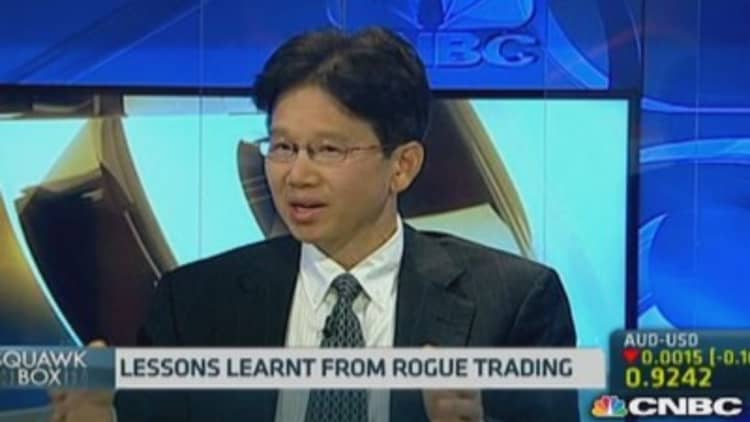Exactly 25 years ago, Britain's oldest investment bank, which listed Queen Elizabeth II among its clients, was declared insolvent.
The collapse of Barings Bank was caused by colossal losses incurred by a single rogue trader.
Nick Leeson, the bank's then 28-year-old head of derivatives in Singapore, gambled more than $1 billion in unhedged, unauthorized speculative trades, an amount which dwarfed the venerable merchant bank's cash reserves.
Leeson's assignment in Singapore was to execute "arbitrage" trade, generating small profits from buying and selling futures contracts on the Japanese Nikkei 225 in both the Osaka Securities Exchange and the Singapore International Monetary Exchange.
However, rather than initiating concurrent trades to capitalize on small differences in pricing between the two markets, he retained the contracts in the hope of creating much larger profits by betting on the rise of the underlying Nikkei index.
He had made vast sums for the bank in previous years, at one stage accounting for 10% of its entire profits, but the downturn in the Japanese market following the Kobe earthquake on January 17, 1995 rapidly unraveled his unhedged positions.
Through manipulating internal accounting systems, Leeson was able to misrepresent his losses and falsify trading records.
This enabled him to keep the bank's London headquarters, and the financial markets, in the dark until a confession letter to Barings Chairman Peter Baring on February 23, 1995, at which point Leeson fled Singapore and kickstarted an international manhunt. Three days later, Britain's oldest merchant bank, founded in 1762, ceased to exist.
Leeson was eventually captured and sentenced to six and a half years in jail in Singapore after pleading guilty to two counts of "deceiving the bank's auditors and of cheating the Singapore exchange."
The fox guarding the hen house
One of the most glaring regulatory errors the bank made was having the same man at the helm of both the derivatives trading desk and the clearing, settling and accounting operation.
ACA Compliance Chief Services Officer Carlo di Florio, a former senior executive at both FINRA (Financial Industry Regulatory Authority) and the U.S. Securities and Exchange Commission (SEC), said this convergence of duties was tantamount having "the fox guarding the hen house."
Today, this would not be permitted either by regulators or the financial institutions themselves, di Florio told CNBC Monday. Financial institutions typically have robust governance, risk management and compliance programs with independent committees and senior executives responsible for their oversight.
He added that post-financial crisis advances in technology, big data, artificial intelligence and cloud computing now allow firms to surveil their employees more closely.
"Today, if you had a Nick Leeson on a trading desk, there would be trade surveillance systems with a whole bunch of triggers continuously looking at what kind of activity he is engaged in, and red flagging anything that seems potentially violative of internal policies or regulatory requirements," di Florio explained.
The scale of harm caused by institutional failures such as Barings, Lehman Brothers and Bear Stearns has also driven a rethink of trader remuneration and bonuses, di Florio highlighted, in a bid to alter the behaviors they incentivize.
"These big institutions won't reward the trader until the trade has proven to be successful and effective and well risk managed, and if there is something that happens, they can go back and claw back the money. That changes the behavior of the trader."
Reduced systemic risk
Since the financial crisis in particular, a number of regulatory measures have been taken to halt excessive and speculative risk taking in derivatives, the first of which is the requirement for all standardized derivatives contracts to be traded through a central clearing counterparty.
"Central clearing is the growing way to trade derivatives, and it means everything has to be reported, everything is going through a few large central players," Veeral Manek, product manager at derivatives analytics platform OpenGamma, told CNBC.
"The way that the risk is managed means that it is very difficult to take huge leveraged exposure as you used to be able to."

The way that margin methodologies are calculated means traders are penalized heavily for concentrating risk with a single counterparty, Manek explained.
Traders being incentivised to spread their risk means that if any single party defaults, there won't be a huge contagion effect as we saw in the financial crisis.
"The flipside is that with all this regulation and higher capital requirements, it does mean that it is becoming harder and harder to trade derivatives more efficiently," Manek explained, adding that the cost of such inefficiencies can be passed on to investors.
Complacency the greatest risk
Di Florio suggested that while the financial system is "safer and sounder" than ever before with greater overall stability, complacency is now the greatest risk.
"We will have another financial crisis, we will have other frauds and abuses. Where they come from may be new and different sources of risk than the last battle that we fought," he predicted.
Cybersecurity, privacy and data security would be the likely target of any future attacks, di Florio suggested.
"Everything is so reliant on tech and the systems are so interconnected that if there is a hack and an attack, it can be exploited like never before."

